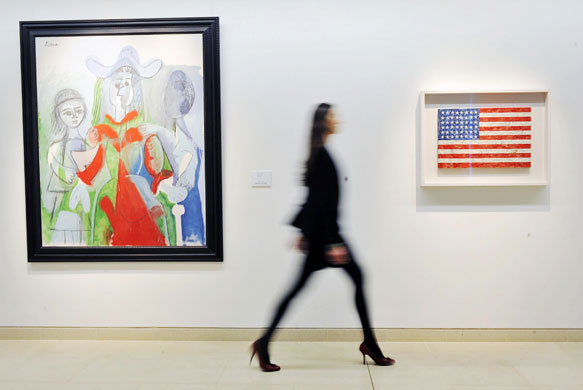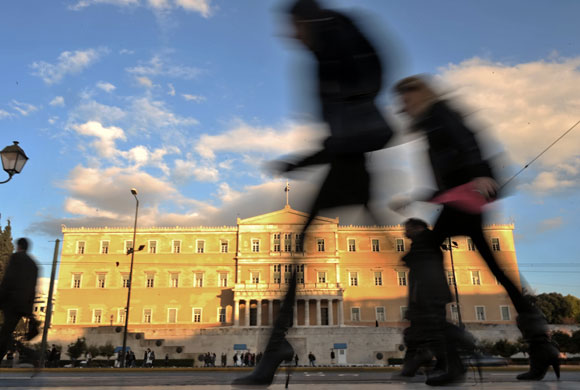One of the pleasures of going to an art gallery is to see the other people there as artworks–that is, as if crafted for display, and displayed to reveal something important about who we are as human beings. Of course, some people seem better suited to being seen this way than others.

This woman striding through a gallery in London seems obviously stylish—high heels, short skirt, long, sleek hair, ramrod posture, stiletto figure, all in basic black, one can go right down the fashion magazine checklist. Less is more, however, and her lean minimalism and striking pose suggest that she is not merely stylish but as much a work of art as the two paintings on either side of her, as if she were the middle panel of a triptych. But for the blurred edges that indicate motion, she could be a sculpture by Alberto Giacometti.

And not just any sculpture, but one that sold this month at a Sotheby’s auction for $103.4 million. That fact may account for the presence of the first photo above, as the publicity about the sale may have activated the Giacometti neuron in at least one photographer’s brain, and the photo was taken at Christie’s auction house, but the woman had to be there as she was for the photograph to be taken at all. And so one artist was paying homage to another, but he could do so in part because the artistic influence was so pervasive that life was already following that art.
No one gets up in the morning to put on their Giacometti outfit, but many do spend a lot of money and effort to appear stylish, and the hundreds of his stick figures that populate museums, books, posters, and other media of the art world played a role in defining the aesthetic norms of contemporary cosmopolitan society. That modernist norms can be traced across art, fashion, and photography as well as interior design, architecture, and other arts is hardly surprising, as a universal economy of representation was the point, but I want to suggest that something more than homology is at stake.

When this photograph turned up as well, I had to wonder what was going on. One answer is that a second photographer had been cued to Giacometti’s gaze. But now I began to think that this was not merely a study in influence, but rather that Giacometti had seen something then that was becoming ever more evident now in modernity’s continued development on its own terms.
But what is being shown? People are transformed into shadows, women are styled into nothingness, mass is consumed by motion, life crafted for the gaze reverts to the vanishing point, all that is solid melts into air. . . . Each of these ideas is a start, but just that, at understanding what is being revealed. And perhaps it is worth noting that the last photo was taken before the Greek parliament building during a week when the Greek financial meltdown was threatening the EU (and world) economy. And so, once again, billions of dollars have gone up in smoke across the globe as modern financial systems operate with the radical autonomy and disregard for common sense that may be a key to artistic innovation, but little else.
Modernism is now seen in some circles as a period style, but some have claimed that modernity will not–cannot–ever end. Even if that were to be true, modernist art and fashion alike might prompt one to ask who, what, and how much caught within modern processes of change will simply vanish.
The first photograph is by Tim Ireland/PA; the third photograph is by Louisa Gouliamaki/AFP-Getty Images. The sculpture may be L’Homme qui marche I or another like it.
I think this old photo is a propos your article, and in that context perhaps more relevant than ever:
http://upload.wikimedia.org/wikipedia/en/1/15/Photograph_of_Alberto_Giacometti_by_Cartier_Bresson.jpg
Best regards,
robert e